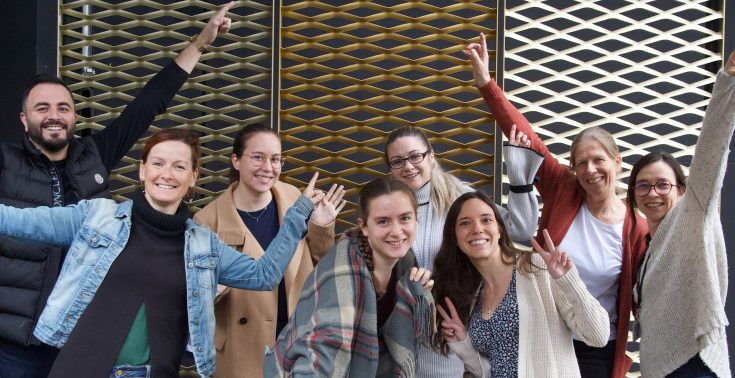Transposable elements (TEs) are mobile genetic sequences that constitute a large fraction of eukaryotic genomes. While their mobility poses a threat to genome integrity, TEs have persisted and expanded, suggesting an evolutionary balance between repression and tolerance. In Drosophila melanogaster, as in other organisms, TE activity is tightly regulated by the piRNA pathway, which ensures transcriptional and post-transcriptional silencing, particularly in gonadal tissues.
Yet, TE repression is not uniformly established during development, and several TEs become transiently expressed in somatic cells. Whether this expression reflects neutral regulatory leakage or functional involvement in developmental processes remains an open question. Some TEs, especially endogenous retroviruses, even encode proteins that may enable intercellular transmission, mimicking viral strategies and challenging the traditional view of TE propagation as strictly cell-autonomous.
Our team investigates the developmental dynamics of TE silencing, the functional potential of TE expression in defined tissues, and the molecular mechanisms enabling soma-to-germline transmission. By studying these processes in Drosophila, we aim to uncover how genomes not only defend themselves against mobile elements but also occasionally engage with them, shaping a complex and evolving relationship between host and TE.
Looking for a PhD, postdoc, or internship opportunity? Get in touch with us.
Financeurs

Recherche
Transposable elements (TEs) are abundant and dynamic components of genomes, capable of both disrupting and shaping genetic information. To investigate these dual roles, our team explores how host genomes regulate TEs, how these controls evolve during development, and how some TEs may be repurposed by the host. Using Drosophila melanogaster as a model, we combine genetics, epigenomics, molecular and cellular biology, and developmental approaches to address three main questions:
How is TE silencing established and preserved through development?
We aim to understand how transposable element repression is initiated during development and how this repression is maintained over time in differentiated cells. In this context, using the Drosophila ovarian soma as a model, we combine genetic tools and live imaging to explore the temporal dynamics of piRNA-mediated silencing and to assess the stability and memory of this repression across developmental stages.Exploring the biological significance of TE expression during development
Some TEs escape silencing and are expressed in specific developmental windows or tissues. To better understand these events, we explore their functional consequences, their potential roles in developmental processes, and the host regulatory circuits that allow or restrict them. Through this work, we contribute to redefining TEs not only as threats but also as possible developmental actors.From soma to germline: decoding the infectious potential of endogenous retroviruses
Some retrotransposons, known as endogenous retroviruses (ERVs), retain genes reminiscent of infectious retroviruses, including envelope-like proteins. In particular, in Drosophila, several of these elements are expressed specifically in somatic follicle cells and have the potential to invade the germline. Our objective is to understand the molecular mechanisms that enable such intercellular transfer, with a particular focus on the role of TE-encoded proteins and their interaction with host factors. To this end, we use genetic, molecular, and proteomic approaches to uncover how endogenous retroelements exploit cellular environments to ensure their propagation.
Membres
Publications
Binding of heterochromatin protein Rhino to a subset of piRNA clusters depends on a combination of two histone marks.
Publié le 17 Juin 2025 dans Nature structural & molecular biology
Akkouche A , Kneuss E, Bornelöv S, Renaud Y , Eastwood EL, van Lopik J, Gueguen N , Jiang M, Creixell P, Maupetit-Mehouas S, Sobieszek A, Gui Y, Czech Nicholson B*, Brasset E* , Hannon GJ*
The transcription factor Traffic jam orchestrates the somatic piRNA pathway in Drosophila ovaries.
Publié le 22 Avr 2025 dans Cell reports , vol. 44 - pp 115453
Alizada A, Martins A , Mouniée N, Rodriguez Suarez JV, Bertin B , Gueguen N , Mirouse V , Papameletiou AM, Rivera AJ, Lau NC, Akkouche A , Maupetit-Méhouas S, Hannon GJ, Czech Nicholson B, Brasset E
Gap junctions allow transfer of metabolites between germ cells and somatic cells to promote germ cell growth in the Drosophila ovary.
Publié le 18 Fév 2025 dans PLoS biology , vol. 23 - pp e3003045
Vachias C , Tourlonias C , Grelée L , Gueguen N , Renaud Y , Venugopal P , Richard G , Pouchin P , Brasset E , Mirouse V
The transcription factor Traffic jam orchestrates the somatic piRNA pathway in Drosophila ovaries
Publié le 12 Sep 2024 dans bioRxiv
Alizada A*, Martins A* , Mouniée N* , Rodriguez Suarez JV*, Bertin B , Gueguen N , Mirouse V , Maupetit-Mehouas S , Rivera AJ, Lau NC, Hannon GJ, Czech Nicholson B, Brasset E.
A dual histone code specifies the binding of heterochromatin protein Rhino to a subset of piRNA source loci.
Publié le 11 Jan 2024 dans bioRxiv
Akkouche A , Kneuss E, Bornelöv S, Renaud Y , Eastwood EL, van Lopik J, Gueguen N , Jiang M, Creixell P, Maupetit-Mehouas S , Czech Nicholson B, Brasset E , Hannon GJ
Reactivation of a somatic errantivirus and germline invasion in Drosophila ovaries.
Publié le 29 Sep 2023 dans Nature communications , vol. 14 - pp 6096
Yoth M , Maupetit-Méhouas S , Akkouche A , Gueguen N , Bertin B , Jensen S , Brasset E
The catalytic-dead Pcif1 regulates gene expression and fertility in Drosophila.
Publié le 01 Mai 2023 dans RNA (New York, N.Y.) , vol. 29 - pp 609-619
Franco G, Taillebourg E, Delfino E, Homolka D, Gueguen N , Brasset E , Pandey RR, Pillai RS, Fauvarque MO
The histone demethylase Kdm3 prevents auto-immune piRNAs production in Drosophila.
Publié le 07 Avr 2023 dans Science advances , vol. 9 - pp eade3872
Casier K, Autaa J, Gueguen N , Delmarre V, Marie PP, Ronsseray S, Carré C, Brasset E , Teysset L, Boivin A
More than just an inert dense region.
Publié le 14 Oct 2022 dans eLife , vol. 11
The Intricate Evolutionary Balance between Transposable Elements and Their Host: Who Will Kick at Goal and Convert the Next Try?
Publié le 06 Mai 2022 dans Biology , vol. 11
The Class I HDAC Inhibitor, MS-275, Prevents Oxaliplatin-Induced Chronic Neuropathy and Potentiates Its Antiproliferative Activity in Mice.
Publié le 22 Déc 2021 dans International journal of molecular sciences , vol. 23
Lamoine S, Cumenal M, Barriere DA, Pereira V, Fereyrolles M, Prival L, Barbier J, Boudieu L, Brasset E , Bertin B , Renaud Y , Miot-Noirault E, Civiale MA, Balayssac D, Aissouni Y, Eschalier A, Busserolles J
Rhino breaks the deadlock in Drosophila testis.
Publié le 02 Sep 2021 dans PLoS genetics , vol. 17 - pp e1009702
Molla Herman A, Brasset E
Conserved Small Nucleotidic Elements at the Origin of Concerted piRNA Biogenesis from Genes and lncRNAs.
Publié le 18 Juin 2020 dans Cells , vol. 9
Jensen S , Brasset E , Parey E, Roest Crollius H, Sharakhov IV, Vaury C
Epigenetic Requirements for Triggering Heterochromatinization and Piwi-Interacting RNA Production from Transgenes in the Drosophila Germline.
Publié le 10 Avr 2020 dans Cells , vol. 9
Komarov PA, Sokolova O, Akulenko N, Brasset E , Jensen S , Kalmykova A
flam piRNA precursors channel from the nucleus to the cytoplasm in a temporally regulated manner along Drosophila oogenesis.
Publié le 06 Juil 2019 dans Mobile DNA , vol. 10 - pp 28
Environmentally-induced epigenetic conversion of a piRNA cluster.
Publié le 15 Mar 2019 dans eLife , vol. 8
Casier K, Delmarre V, Gueguen N , Hermant C, Viodé E, Vaury C , Ronsseray S, Brasset E , Teysset L, Boivin A
The interplay between the Argonaute proteins Piwi and Aub within Drosophila germarium is critical for oogenesis, piRNA biogenesis and TE silencing.
Publié le 02 Nov 2018 dans Nucleic acids research , vol. 46 - pp 10052-10065
Théron E, Maupetit-Mehouas S, Pouchin P , Baudet L , Brasset E , Vaury C
Transcriptional and chromatin changes accompanying de novo formation of transgenic piRNA clusters.
Publié le 30 Avr 2018 dans RNA (New York, N.Y.) , vol. 24 - pp 574-584
Akulenko N, Ryazansky S, Morgunova V, Komarov PA, Olovnikov I, Vaury C , Jensen S , Kalmykova A
sRNAPipe: a Galaxy-based pipeline for bioinformatic in-depth exploration of small RNAseq data.
Publié le 01 Jan 2018 dans Mobile DNA , vol. 9 - pp 25
Pogorelcnik R , Vaury C , Pouchin P , Jensen S , Brasset E
Export of piRNA precursors by EJC triggers assembly of cytoplasmic Yb-body in Drosophila.
Publié le 08 Déc 2016 dans Nature communications , vol. 7 - pp 13739
Increased production of piRNAs from euchromatic clusters and genes in Anopheles gambiae compared with Drosophila melanogaster.
Publié le 27 Nov 2015 dans Epigenetics & chromatin , vol. 8 - pp 50
George P, Jensen S , Pogorelcnik R , Lee J, Xing Y, Brasset E , Vaury C , Sharakhov IV
PIWI Slicing and RNA Elements in Precursors Instruct Directional Primary piRNA Biogenesis.
Publié le 21 Juil 2015 dans Cell reports , vol. 12 - pp 418-28
Homolka D, Pandey RR, Goriaux C , Brasset E , Vaury C , Sachidanandam R, Fauvarque MO, Pillai RS
Distinct features of the piRNA pathway in somatic and germ cells: from piRNA cluster transcription to piRNA processing and amplification.
Publié le 20 Déc 2014 dans Mobile DNA , vol. 5 - pp 28
Microsporidian genomes harbor a diverse array of transposable elements that demonstrate an ancestry of horizontal exchange with metazoans.
Publié le 28 Août 2014 dans Genome biology and evolution , vol. 6 - pp 2289-300
Parisot N, Pelin A, Gasc C, Polonais V, Belkorchia A, Panek J, El Alaoui H, Biron DG, Brasset E , Vaury C , Peyret P, Corradi N, Peyretaillade É, Lerat E
History of the discovery of a master locus producing piRNAs: the flamenco/COM locus in Drosophila melanogaster.
Publié le 04 Août 2014 dans Frontiers in genetics , vol. 5 - pp 257
Distribution, evolution, and diversity of retrotransposons at the flamenco locus reflect the regulatory properties of piRNA clusters.
Publié le 03 Déc 2013 dans Proceedings of the National Academy of Sciences of the United States of America , vol. 110 - pp 19842-7
Zanni V, Eymery A, Coiffet M, Zytnicki M, Luyten I, Quesneville H, Vaury C , Jensen S
De novo piRNA cluster formation in the Drosophila germ line triggered by transgenes containing a transcribed transposon fragment.
Publié le 30 Juin 2013 dans Nucleic acids research , vol. 41 - pp 5757-68
Olovnikov I, Ryazansky S, Shpiz S, Lavrov S, Abramov Y, Vaury C , Jensen S , Kalmykova A
Epigenetics and transgenerational inheritance.
Publié le 24 Mai 2013 dans Genome biology , vol. 14 - pp 306
Brasset E , Chambeyron S
NucBase, an easy to use read mapper for small RNAs.
Publié le 01 Jan 2013 dans Mobile DNA , vol. 4 - pp 1
Transcript levels, alternative splicing and proteolytic cleavage of TFIIIA control 5S rRNA accumulation during Arabidopsis thaliana development.
Publié le 30 Juil 2012 dans The Plant journal : for cell and molecular biology , vol. 71 - pp 35-44
Layat E , Cotterell S , Vaillant I , Yukawa Y, Tutois S , Tourmente S
Polycomb group-dependent, heterochromatin protein 1-independent, chromatin structures silence retrotransposons in somatic tissues outside ovaries.
Publié le 30 Déc 2011 dans DNA research : an international journal for rapid publication of reports on genes and genomes , vol. 18 - pp 451-61
An siRNA pathway prevents transgenerational retrotransposition in plants subjected to stress.
Publié le 07 Avr 2011 dans Nature , vol. 472 - pp 115-9
Ito H, Gaubert H, Bucher E, Mirouze M, Vaillant I , Paszkowski J
Stress-induced activation of heterochromatic transcription.
Publié le 28 Oct 2010 dans PLoS genetics , vol. 6 - pp e1001175
Tittel-Elmer M, Bucher E, Broger L, Mathieu O , Paszkowski J, Vaillant I
MOM1 and Pol-IV/V interactions regulate the intensity and specificity of transcriptional gene silencing.
Publié le 20 Jan 2010 dans The EMBO journal , vol. 29 - pp 340-51
Yokthongwattana C, Bucher E, Caikovski M, Vaillant I , Nicolet J, Mittelsten Scheid O, Paszkowski J
The Idefix enhancer-blocking insulator also harbors barrier activity.
Publié le 15 Jan 2010 dans Gene , vol. 450 - pp 25-31
Genomic environment influences the dynamics of the tirant LTR retrotransposon in Drosophila.
Publié le 30 Mai 2009 dans FASEB journal : official publication of the Federation of American Societies for Experimental Biology , vol. 23 - pp 1482-9
Fablet M, Lerat E, Rebollo R, Horard B, Burlet N, Martinez S, Brasset E , Gilson E, Vaury C , Vieira C
Functional characteristics of a highly specific integrase encoded by an LTR-retrotransposon.
Publié le 11 Sep 2008 dans PloS one , vol. 3 - pp e3185
Faye B, Arnaud F, Peyretaillade E, Brasset E , Dastugue B, Vaury C
Domain organization of human chromosomes revealed by mapping of nuclear lamina interactions.
Publié le 12 Juin 2008 dans Nature , vol. 453 - pp 948-51
Guelen L, Pagie L, Brasset E , Meuleman W, Faza MB, Talhout W, Eussen BH, de Klein A, Wessels L, de Laat W, van Steensel B
Hypomethylation and hypermethylation of the tandem repetitive 5S rRNA genes in Arabidopsis.
Publié le 30 Avr 2008 dans The Plant journal : for cell and molecular biology , vol. 54 - pp 299-309
Vaillant I , Tutois S , Jasencakova Z, Douet J, Schubert I, Tourmente S
Maintenance of long-range DNA interactions after inhibition of ongoing RNA polymerase II transcription.
Publié le 20 Fév 2008 dans PloS one , vol. 3 - pp e1661
Palstra RJ, Simonis M, Klous P, Brasset E , Eijkelkamp B, de Laat W
















